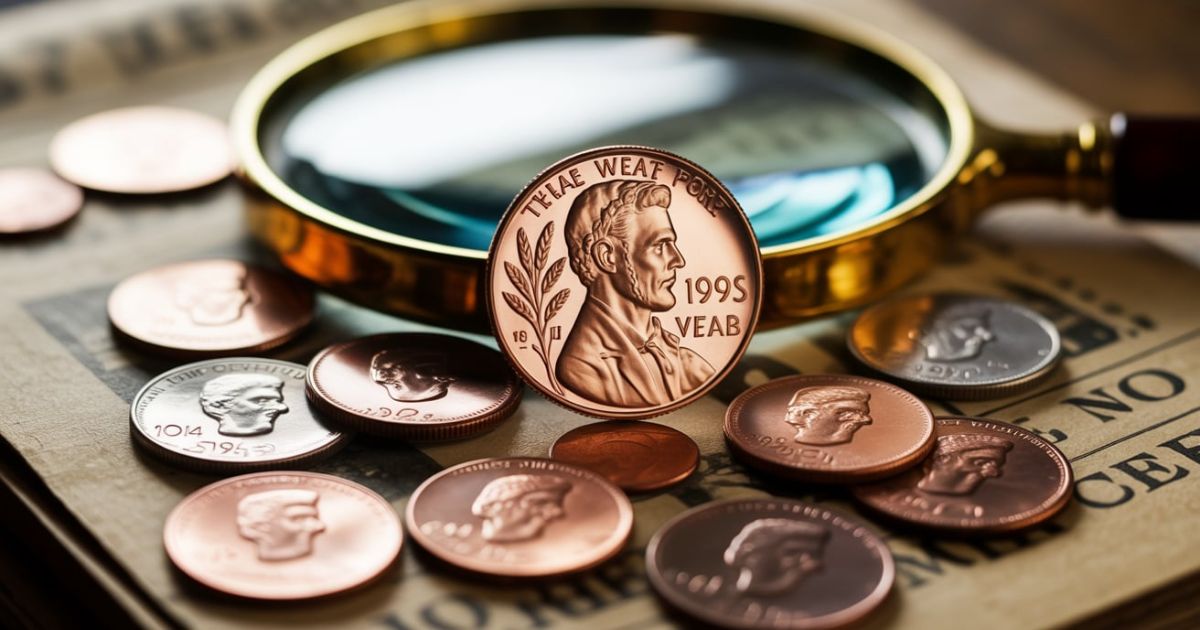Ever found a penny so old it feels like a piece of history? Wheat pennies, minted from 1909 to 1958, are more than pocket change—they’re tiny treasures that spark joy for collectors across the USA.
Some wheat pennies value skyrockets into the thousands, like the rare 1943 bronze penny, while others are worth just a few cents.
This guide dives into the value of wheat pennies by year, helping you spot coins worth money, understand what drives their price, and kickstart your collecting journey. Ready to hunt for hidden gems? Let’s explore!
Read More: Shanin Blake: Age, Net Worth, Career, Relationship [2025]
What Are Wheat Pennies?
Wheat pennies, officially called Lincoln Wheat Cents, first jingled in pockets in 1909 to celebrate Abraham Lincoln’s centennial birthday.
Designed by Victor D. Brenner, these coins boast Lincoln’s portrait on the front and two wheat stalks framing “ONE CENT” on the back—giving them their iconic name. For example, the 1909-S VDB, with Brenner’s initials, became a legend due to its low mintage of just 484,000.
Minted until 1958, these coins capture America’s story, from the Roaring Twenties to World War II. Most are copper, but 1943’s steel pennies, made to save copper for the war, stand out as a quirky exception.
“Wheat pennies are like time capsules, each one telling a story of its era.” – Numismatic enthusiast
Why Do Some Wheat Pennies Have More Value?
Not every wheat penny is a goldmine. Rarity, condition, and minting errors decide which ones shine. Low-mintage years, like 1909-S or 1931-S, fetch high prices due to scarcity.
Errors, such as the 1955 Double Die, where the date appears doubled, can push a penny’s worth to $1,900 or more.
Collectors also chase valuable wheat cents to complete sets, driving demand. For instance, a 1914-D in good shape might sell for $200, while a common 1940s penny could be worth just 10 cents. Knowing these factors helps you spot wheat pennies worth money in your change.
Key Factors Driving Value:
- Mintage: Fewer coins mean higher value (e.g., 1931-S, only 866,000 minted).
- Errors: Mistakes like double dies or wrong metals boost prices.
- Demand: Popular coins for collectors increase in worth.
Understanding Mint Marks
Coin mint marks are tiny clues that reveal where a penny was made, and they’re critical for gauging wheat penny values. Check beneath the date: “S” stands for San Francisco, “D” for Denver, and no mark means Philadelphia.
San Francisco often minted fewer coins, making “S” pennies like the 1909-S VDB rare gems. For example, only 484,000 1909-S VDB pennies exist, compared to millions from Philadelphia.
The 1914-D, with just 1.2 million struck, is another prize. How to spot a valuable penny? Start with the mint mark—it’s a quick way to assess coin rarity.
| Mint Mark | Location | Impact on Value |
| S | San Francisco | Often rare, higher value |
| D | Denver | Some years rare, e.g., 1914-D |
| None | Philadelphia | Typically common, lower value |
Rarest Wheat Pennies to Watch For
Some rare wheat pennies are the holy grails of coin collecting. These coins, often low-mintage or error coins, can transform a penny into a fortune. Here’s a rundown of the most valuable wheat pennies:
- 1909-S VDB: Only 484,000 minted, worth $700–$15,000+.
- 1914-D: Just 1.2 million made, fetching $200–$3,000.
- 1931-S: 866,000 minted, valued at $40–$500.
- 1943 Bronze: A rare error, worth $100,000–$840,000.
- 1944 Steel: Another error, valued at $30,000–$100,000.
- 1955 Double Die: Date doubling, worth $500–$1,900.
Case Study: In 2021, a 1943 bronze penny sold for $840,000 at auction, proving rare wheat pennies can be life-changing finds. Always authenticate suspected rarities with services like PCGS (www.pcgs.com) to avoid fakes.
How Condition Affects Value
Coin condition value is everything in collecting. A shiny, uncirculated penny trumps a worn one every time. Collectors use the Sheldon scale (1–70), where MS60+ means mint state. For example, a 1931-S penny in fine condition might fetch $40, but in MS65, it could hit $500.
Look at the wheat stalks on the back—crisp lines signal better condition, while worn stalks suggest heavy use. Never clean coins; it damages value. Grading by PCGS or NGC clarifies wheat penny price and boosts trust when selling.
Tips to Assess Condition:
- Check Lincoln’s face for sharp details.
- Examine wheat stalks for clear lines.
- Avoid scratches or discoloration.
Wheat Penny Values by Year
Curious about wheat penny values by year? Here’s a table of key dates and their approximate values in circulated and uncirculated conditions, based on recent market trends:
| Year | Circulated Value | Uncirculated Value (MS65) |
| 1909-S VDB | $700–$2,000 | $10,000–$15,000+ |
| 1914-D | $200–$500 | $2,000–$3,000 |
| 1922 No D | $350–$1,500 | $10,000–$12,000 |
| 1931-S | $40–$100 | $400–$500 |
| 1943 Bronze | $60,000–$200,000 | $500,000–$840,000 |
| 1944 Steel | $30,000–$50,000 | $75,000–$100,000 |
| 1955 Double Die | $500–$1,000 | $1,500–$1,900 |
| 1940s–1950s (Common) | $0.02–$0.50 | $1–$10 |
For a complete coin price guide, check resources like the Red Book or NGC’s website (www.ngccoin.com). Values shift with market demand, so stay updated.
How to Start Collecting Wheat Pennies
Collect wheat pennies for a hobby that’s both fun and affordable. Start by sifting through pocket change or coin rolls from banks—old wheat pennies still surface!
Focus on key dates like 1909-S VDB or semi-key dates like 1931-S. Organize by year or mint mark to build a set. For example, aim for one penny per year from 1909 to 1958, or collect all mint marks for 1911.
Join numismatic communities on platforms like Reddit to learn about coin values. Store coins in acid-free holders to preserve their coin condition value.
Beginner Tips:
- Buy a magnifying glass to inspect coins.
- Use a Red Book for reference.
- Join a local coin club for advice.
Where to Sell or Get Coins Appraised
Ready to cash in on valuable old coins? Here are trusted options for selling or appraising:
- Coin Dealers: Local shops or online platforms like GovMint.com (www.govmint.com) offer fair deals.
- Coin Shows: Meet dealers and collectors for quick appraisals.
- Online Marketplaces: eBay or Etsy, but watch for scams or inflated prices.
- Grading Services: PCGS (www.pcgs.com) or NGC (www.ngccoin.com) authenticate and grade, boosting penny value.
- Auctions: Heritage Auctions (www.ha.com) or Stack’s Bowers handle high-value sales.
For instance, a 1909-S VDB in MS65 sold for $15,000 at a 2023 auction. Get rare coins graded to maximize coin appraisal value and avoid fakes.
Final Thoughts
Wheat pennies are more than old coins—they’re a gateway to history and hidden wealth. From the rarest wheat cents like the 1943 bronze to common 1950s pennies, understanding wheat pennies value by year unlocks their potential.
With a keen eye for mint marks, condition, and key dates, you can turn pocket change into a treasure hunt.
Whether you’re starting to collect wheat pennies or eyeing a sale, these coins reward patience and curiosity. So, grab that jar of pennies—you might just uncover a Lincoln wheat penny worth thousands. Happy collecting!
FAQs
What is the most valuable wheat penny?
The 1943 bronze wheat penny tops the list, fetching $100,000–$840,000 due to its rare minting error.
Are wheat pennies still in circulation?
Yes, wheat pennies occasionally appear in pocket change, but most are now in collections or hoarded.
Can I clean my wheat pennies to make them look better?
No, cleaning wheat pennies damages their surface and reduces value; leave them untouched.
Do all old pennies have value?
Not all old pennies are valuable; common wheat pennies from the 1940s–1950s may be worth just cents.











